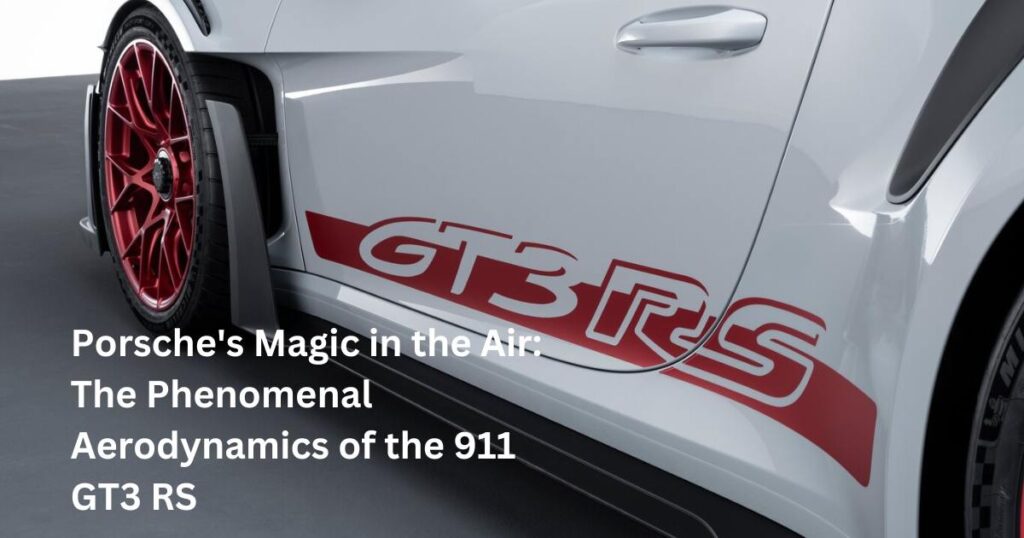If you’re a speed aficionado, chances are you’ve had your heart set on the Porsche 911 GT3 RS. It’s not just about pure power and agility; it’s also about the way it sticks to the tarmac like a champion gymnast, and the secret sauce behind that magic is none other than aerodynamics. The latest iteration of the 911 GT3 RS takes downforce to a whole new level, making it a track-dominating force to be reckoned with. So, let’s take a deep dive into the world of airflow management and drag reduction that Porsche has cooked up for the 911 GT3 RS.

Setting the Stage
To truly appreciate the aerodynamic prowess of this track-focused beast, we need to roll back the years. The previous GT3 RS model was no slouch in the downforce department, but the latest iteration boasts more than twice the downforce of its predecessor and three times the downforce of the regular GT3. Buckle up; it’s about to get exciting.
Under the Bonnet
The journey into the aerodynamic wonderland starts under the carbon bonnet, or what used to be a load bay in every other 911. Porsche has taken a page from its race car playbook, turning three small radiators into one colossal unit. This transformation not only aids in efficient cooling but also opens up a canvas for some serious aerodynamic artistry.
Porsche’s Active Aero (PAA)
Hidden behind the scenes are active aerodynamic marvels. Remember those small light bars where radiators used to reside? They are history now, making way for the Porsche Active Aero (PAA) system at the front axle. The PAA system employs movable flaps that can pivot more than 80 degrees in a mere 0.3 seconds, giving you that extra downforce exactly when you need it. It’s like having a virtual co-pilot to adjust the car’s grip on the fly.
Behind the Scenes – Suspension
Up front, the suspension arms don a wing-profile, adding 40 kilograms of downforce when the GT3 RS is at full tilt. It’s an elegant solution that combines aesthetics and performance in one sleek package.
Wheel Arch Vents
More air coming into the front wheel arch means more pressure, so Porsche enlarged the vents to evacuate air efficiently. It’s all about maintaining that delicate balance between pressure and speed, ensuring that the GT3 RS remains glued to the road.
Revamped Door Area
To tackle airflow and pressure build-up around the wheel arch area, Porsche decided to take the scalpel to the doors. The result? A redesigned door area, complete with a vertical deflector that guides departing air down the car’s sides. It’s all part of the grand plan to minimize turbulence and maximize stability.
Underbody Secrets
Take a closer look underneath the front, and you’ll see a network of vents and flicks. These nifty contraptions channel airflow under the car, each serving a specific purpose. Some help cool the brakes, while others work to increase downforce by reducing underbody pressure. It’s all about the art of balance.
Heat Management
While the hot air from the radiator gets funneled through the mesh on the bonnet, the vanes play a crucial role. They twist and turn the air, guiding it across the bonnet to exit sideways rather than rising over the top. This not only keeps the engine cool but also contributes to the car’s aerodynamic efficiency.
Engine Air Intake
Speaking of engine cooling, the air intake is a spectacle of its own. Located on the back deck, under the wing, it’s all about ensuring that the engine gets the coolest, most refreshing air possible. After all, a high-performance engine deserves nothing but the best.
The Mighty Rear Wing
And now, the pièce de résistance: the rear wing. It’s a marvel of engineering and, quite frankly, a mystery in terms of regulatory approval. It’s not your run-of-the-mill wing; it’s a swan-neck wing. This design choice makes the lower surface of the wing work efficiently to generate maximum downforce.
In fact, this wing is a whopping 40% larger than its predecessor. It’s not just for show; it’s a functional masterpiece.
Active Functionality
This wing isn’t just for show; it’s smart. An ingenious hydraulic piston operates the Drag Reduction System (DRS), reducing downforce by 30% when necessary. You can manually engage it with a button on the steering wheel, or it can kick in automatically when specific conditions are met, like cruising above 62 mph and using at least 95% of the throttle travel. It’s a feature straight out of the Formula 1 playbook.
Looking Ahead
The Porsche 911 GT3 RS continues to push the envelope, but there’s always room for improvement. The rear diffuser, while effective, isn’t adapted much from the standard GT3, possibly hinting at the need for a mid-engine 911 in the future. Only time will tell where Porsche takes this high-performance legend next.
Final Verdict
In conclusion, Porsche’s aerodynamic wizardry has transformed the 911 GT3 RS into a track monster that sticks to the road like glue, defying gravity and delivering an unparalleled driving experience. Whether you’re rocketing down the straightaways or conquering hairpin turns, this is the aerodynamic marvel that will leave you breathless.
So, buckle up, folks, because the Porsche 911 GT3 RS is not just a sports car; it’s a testament to the art of aerodynamics in motion, and it’s ready to redefine your notion of speed and precision on the track.
